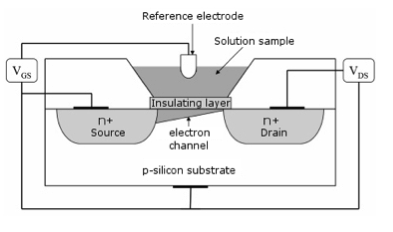**** Master Project ****
Contacts:
Dr. MER Sandro Carrara, Senior Researcher, EPFL-IC-ISIM-LSI
Dr. Peter Van der Wal, Scientist, EPFL-STI-IMT/NE-SAMLAB
Dr. Ulrike Lehmann, Scientist, MICROSENS
Introduction:
Ion Selective Field Effect Transistors (ISFET) are novel integrated devices for micro electrochemical Lab-on-a-Chip systems. These are the most common types of ChemFETs (chemically sensitive field-effect transistors), where the structure is the same as that of a normal metal-oxide-semiconductor field-effect transistor (MOSFET) except for the transistor gate, which represents the sensitive area and incorporates the means of transduction from an ion concentration to a voltage. In the case of an ISFET, the metal gate and gate oxide of a general MOSFET are replaced by the sample solution with a reference electrode immersed in the solution and an insulating layer appropriate for detecting a specific analyte. The nature of the insulating layer generally defines the functionality and sensitivity of the ISFET sensor. Most common ISFETs are pH-ISFET using Si3N4, Al2O3 or Ta2O5 on SiO2, as insulating gates with a high selectivity for H+ ions due to the active groups at the oxide surface. The selectivity of the ISFET can be varied via the addition of ion-sensing or ion-blocking membranes, thus allowing also the detection of other species. Most generally the ion-selectivity is achieved by adding ionophores to the membrane material.

Schematics of the ISFET principle
Project tasks:
The Ta2O5 insulated gate ISFET provided by MICROSENS is known to be a good pH sensor. Operating the ISFET with a constant drain current Id = 0.1mA and a source drain voltage Vds=0.5V, the sensor output will be represented by Vgs measured between the source S and the reference electrode G. The resulting slope with pH units is Vgs ~= 56mV/pH.
In order to extend the usability of the ISFET sensor, this project aims at studying the deposition and the evaluation of ion-selective membranes for the selective detection of potassium (K+), Nitrate (NO3-), Phosphate (H2PO4- or HPO32-)
Elegibility requirements:
- Basic knowledge on biosensors
- Basic knowledge of chemistry
- Interest and motivation